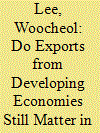| Srl | Item |
| 1 |
ID:
188447


|
|
|
|
|
| Summary/Abstract |
Amid ever-growing global value chains (GVCs), a major controversial topic relates to the extent to which developing economies benefit from participating in such value chains. To measure these gains, this paper examines data pertaining to value-added in exports from three Southeast Asian economies—Malaysia, Thailand and Vietnam. The study estimates the sectoral income elasticities of the export demand of each country over the period 1980–2017, revealing that the highest income elasticities are observed in low value-adding sectors such as primary products, resource-based goods and low-tech industries. This implies that the three countries have been involved in simple and not high-skill tasks within GVCs. The paper also examines the sectoral domestic share of value-added (DVA) and foreign share of value-added (FVA) of exports of the three economies using the OECD Trade in Value-added (TiVA) database over the period 2005–15. We find that DVA in the medium- and high-tech industries that add greater value is smaller than FVA in all three countries. Overall, these results suggest that developing nations need to step up their participation in GVCs through process and/or function upgrading.
|
|
|
|
|
|
|
|
|
|
|
|
|
|
|
|
| 2 |
ID:
170091


|
|
|
|
|
| Summary/Abstract |
In this paper, we use China’s value-added tax (VAT) reform in 2007, which was aimed to encourage fixed investment purchasing, as a natural experiment to explore the effect on firm financial leverage. Results show an expansion in firm balance sheet after the reform, manifested by greater liabilities (long-term, short-term and total liability) and asset. Moreover, in terms of the ratio to asset, it’s found that long-term liability rose while the short-term liability dropped, and as a net effect, the total asset-liability ratio declined as the latter effect dominated. To theoretically explain the observed patterns, three mechanisms are highlighted, “income effect”, “maturity-match effect” and “market disciplining effect”, where income effect corresponds to a proportional expansion of balance sheet while the latter two effects alter the composition of firm leverage.
|
|
|
|
|
|
|
|
|
|
|
|
|
|
|
|